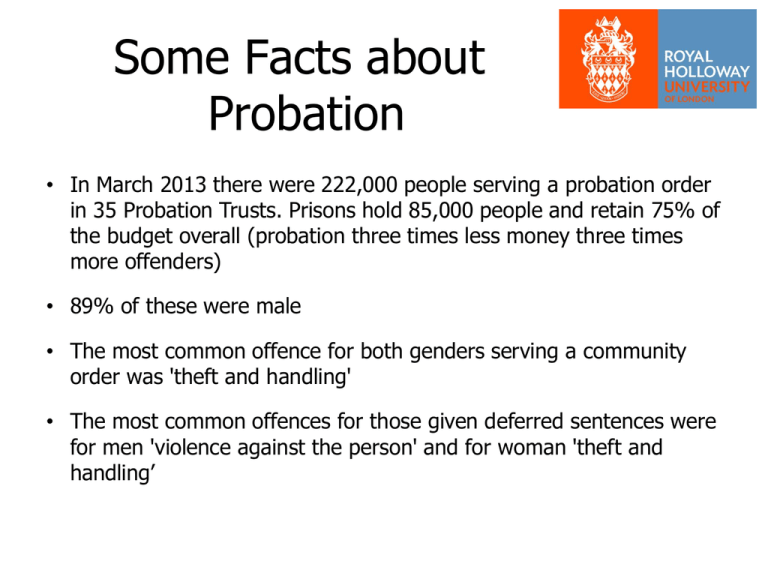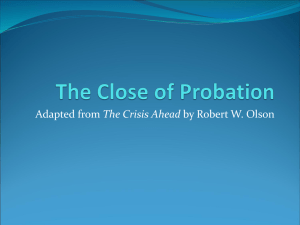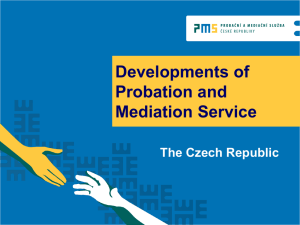Probation and Mental Health - Office of the Police and Crime
advertisement

Some Facts about Probation • In March 2013 there were 222,000 people serving a probation order in 35 Probation Trusts. Prisons hold 85,000 people and retain 75% of the budget overall (probation three times less money three times more offenders) • 89% of these were male • The most common offence for both genders serving a community order was 'theft and handling' • The most common offences for those given deferred sentences were for men 'violence against the person' and for woman 'theft and handling’ Some Facts about Probation in the Future • About 70% of the probation population will become managed by the private and voluntary sector over the next 6-9 months. • Those serving short sentences will be included for the first time • Payment will be linked to reductions in re-offending • Current probation trusts are barred from tendering for business although some staff have been transferred. Some Facts about NHS Reforms • Since April 2013 healthcare has been commissioned by two bodies NHS England and 211 Clinical Commissioning Groups • As far as healthcare for offenders is concerned there is a fundamental split • NHS England commissions healthcare for offenders who are detained (prison, police custody and secure children's homes). • The CCGs are responsible for commissioning health care for local communities (each has a population of 250,000) thus explicit guidance that they purchase healthcare for those on probation • The function of Public Health also fragmented between LA's, Public health England and NHS England What is known about the healthcare needs of those serving probation orders? • Health needs Assessments are limited in probation only eight nationally (8/35) whereas there will be at least one for every prison (130/130) and police custody setting (38/38 forces ) • Role of the Inspectorates (Prison and police examine health, probation do not include health in inspection) • Amount of research small, i.e. prevalence of mental health disorders only two studies world-wide, however 250 plus in prisons • Seminal study by Binswanger et al showing that SMRs are elevated x 12 in the first two weeks after leaving prison (based on 30,000 released from Washington State Corrections centre) main causes of death are overdose, CHD, homicide and suicide. • Little made of official suicide statistics in probation The Derbyshire and Nottinghamshire HNA This study was reported in 2008 and the review of the literature led to some tentative conclusions: • The prevalence of MH problems appeared similar to that of prisoners • Problems of alcohol/Drug misuse and suicide exceeded those in prisons • Recently-released offenders especially vulnerable in terms of mortality and substance misuse • Those on probation have significantly higher health needs than the general population and are less likely to access primary healthcare Main Results • 27% had been formally seen by a MH service mostly for depression and anxiety mostly for depression and anxiety • 83% smoked • 44% at risk of a serious drinking problem • 39% had a high risk of substance misuse • The physical and mental health component scores of the SF-36 were significantly worse than social class V of the general population An Investigation into the Prevalence of Mental Health Disorder and Patterns of Health Service Access in a Probation Population Professor Charlie Brooker – Royal Holloway, University of London Stage One Stage 1: Aims • Stage one investigated: – The prevalence of mental health disorder and substance misuse in a probation population Stage 1: Method All participants interviewed up to the Amended PriSnQuest Those screening positive on this tool + a sub-sample for a false-negative check complete the remaining tools Selection Tools • Tools were selected based on the following criteria: – Previous use in criminal justice settings – Quick to use – Suitable for use by ‘lay’ persons – Good rates of sensitivity and specificity Stage 1: Findings: Prevalence Disorder Weighted Estimate (%) Current mood disorder 18.0 Current anxiety disorder 27.0 Current psychotic disorder 11.0 Current eating disorder 5.0 Any current disorder 39.0 Past/lifetime mood disorder 44.0 Past/lifetime psychotic disorder 18.5 Any past/lifetime disorder 49.0 ‘Likely’ case of PD 47.0 Substance Misuse • 55.5% scored 8+ on AUDIT – strong likelihood of hazardous/harmful alcohol consumption • 40% of the above participants reported accessing a substance misuse service • 12.1% scored 11+ on DAST – substantial/ severe levels of drug use • 88% of the above participants reported accessing a substance misuse service Comorbidity • 72% of those assessed to have a current mental illness also had a substance misuse problem • 89% of those with a current mental illness also had a personality disorder Needs • Those with a current mental illness had a higher mean level of need than those without (mean CANFOR-S scores of 10.53 and 4.59) • There was a statistically significant difference between these two groups in terms of their ‘met’ and ‘unmet’ needs scores at the p=<0.05 level Access to Services • Overall low levels of service access were reported • No mental health service access was reported by: – 60% – 59% – 50% – 75% – 55% of of of of of current mood disorder cases current anxiety disorder cases current psychotic disorder cases current eating disorder cases ‘likely’ cases of PD Stage 2 Stage 2: Aim • Compare findings from stage one interviews to information in probation case files to determine: – the extent to which probation staff were aware of and recording offenders’ mental health and substance misuse problems – What is recorded about offenders’ access to health services in probation files Stage 2: Findings: Recording of Disorders/Substance Misuse • Findings for ‘complete’ files suggest that the following proportions of cases identified in stage 1 interviews were also recorded in probation files: – – – – – Any Any Any Any Any current mood disorder: 73% current anxiety disorder: 47% current psychotic disorder: 33% current eating disorder: 0% likely PD: 21% – 11+ on DAST: 83% – 8+ on AUDIT: 79% Access to Services • In a third of cases participants told a researcher that they were accessing a mental health service but this was not recorded in their file • Qualitative data highlighted the following barriers to service access: – Motivation – Dual diagnosis – Services’ referral criteria Derbyshire Example of Good Practice The Situation in Derbyshire • One of few areas to have an HNA but now eight years out of date (2008) • From series of FOIs to MH Trusts one of the better models in operation • Consisting of m-d support from CJ MHT to probation both face-to-face and by phone • Weekly clinics at 6 probation offices • Does the resource impact on MHTRs? Improve outcomes? Implication for MH Crisis Concordat • CCGs are required under the Crime and Disorder Act (1998) to work in partnership with the police in Community Safety Partnerships • These partnerships should make strategic assessments of crime, anti-social behaviour, substance misuse and develop local strategies • NHS England as part of it’s Parity of Esteem programme will produce effective tool/resources for commissioning Probation and the Concordat • Need an integrated response to mental health crisis across the CJ system • How? The Concordat states ‘through preventing crisis through early intervention and prevention’ • ‘Meeting the needs of vulnerable people in urgent situations’ • An element of this has to be improved MH services for those who are offenders in the community Models of MH Intervention in Probation • The Lincolnshire Model ? Health support service offering connection with services and some intervention. No impact on uptake of MHTRs • The US model? Training probation staff to be specialist mental health practitioners – needs evaluation in UK context • The Northern Ireland model ? six clinical psychologists working full-time on assessment and treatment – unaffordable. (Continued) • The Milton Keynes model? Clinical psychology input for people on MHTRs • Requires magistrate training and clinical psychology resources (IAPT?) • Indication are a tenfold increase in MHTRs in first six weeks (from 3 in 2013 to 30 in first six weeks) • Outcomes and re-offending rates unknown Contact Details • Professor Charlie Brooker cbrooker@rhul.ac.uk 07540 307525 This PowerPoint presents independent research commissioned by the National Institute for Health Research (NIHR) under the Research for Patient Benefit Programme. The views expressed in this presentation are those of the authors and not necessarily those of the NHS, the NIHR or the Department of Health







